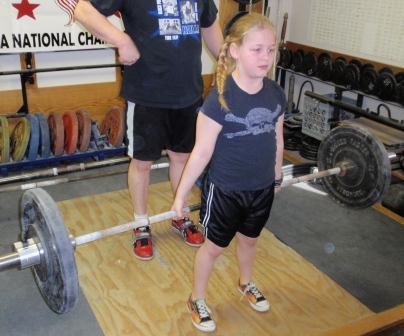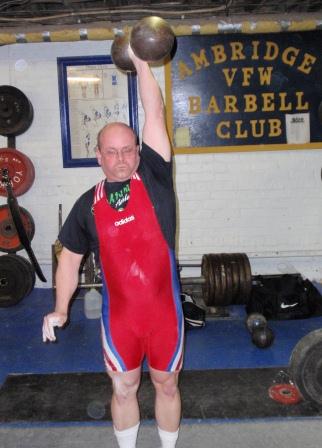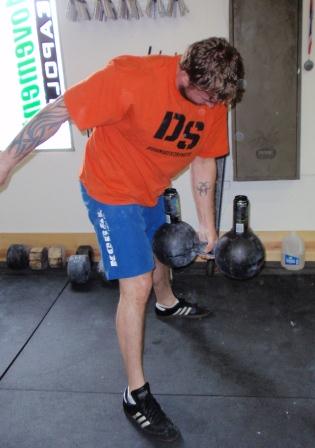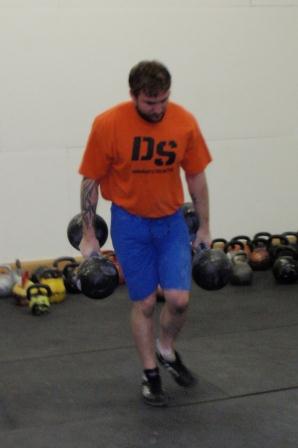Best Lifting Performances in Past Deanna Springs Meets
by Al Myers
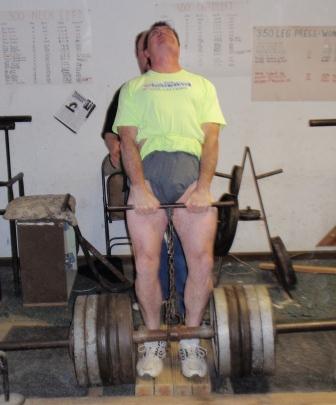
Joe Garcia uses his signature lift, the Hand and Thigh Lift, to lift 1400 pounds to secure his victory at the 2011 Deanna Springs Meet. That win gives Joe 10 ALL TIME wins in this meet, which is the most of any lifter.
The annual Deanna Springs Memorial Meet is coming up this weekend at Clark’s Gym, in Columbia Missouri. I have been to this meet several times, and it is one that I enjoy. It provides a unique combination of lifts – Crucifix, Cheat Curl, Deanna Lift, Hand and Thigh Lift, and Hip Lift. We always start with the Crucifix and Cheat Curl and then finish with the “heavy stuff”. These first two events are merely warmups for the serious heavy lift events. The competition often will come down to the last event of the day, the Hip Lift, to decide who the winner is.
A couple of years ago Dale Friesz wrote a very nice story summarizing the history of the Deanna Meet. It is mainly a long list of victories by Joe Garcia, the Clark’s Gym Phenom. Last year at the Deanna Joe won his TENTH Deanna Meet – out of the 16 meets in the history of this long running meet. Abe Smith has won two (2002 & 2007), John Carter one (1997), Josh Pemberton one (2000), Steve Schmidt one (2006), and myself once (2008). The only reason I was able to win in 2008 was that I was the only one who showed up that year!!! LOL Most of the time at this one I’m sucking up the chalkdust thrown up by Joe after his big finale Hip Lifts!
Today I want to look back at some of the BEST lifting performances ever done at the Deanna Meet. I am only going to include meets from 1998 on, as that was when the lifts remained constant at the five done today.
TOP ADJUSTED POINTS
| LIFTER | YEAR | POINTS | |
| 1 | Abe Smith | 2005 | 4111.98 |
| 2 | Joe Garcia | 2011 | 4018.08 |
| 3 | Joe Garcia | 1999 | 3876.54 |
| 4 | Joe Garcia | 2009 | 3711.88 |
| 5 | Joe Garcia | 2006 | 3655.85 |
| 6 | Steve Schmidt | 2003 | 3654.37 |
| 7 | Joe Garcia | 2004 | 3650.87 |
| 8 | Al Myers | 2011 | 3630.91 |
| 9 | Joe Garcia | 2002 | 3627.67 |
| 10 | Abe Smith | 2003 | 3620.00 |
TOP TOTALS
| LIFTER | YEAR | TOTAL | |
| 1 | Sam Huff | 2005 | 4700 |
| 2 | Joe Garcia | 1999 | 4525 |
| 3 | Al Myers | 2011 | 4385 |
| 4 | Al Myers | 2010 | 4230 |
| 5 | Eric Todd | 2005 | 4145 |
| 6 | Joe Garcia | 1998 | 4140 |
| 7 | Joe Garcia | 2002 | 4120 |
| 8 | Abe Smith | 2005 | 4105 |
| 9 | Eric Todd | 2002 | 4045 |
| 10 | Joe Garcia | 2006 | 4035 |
